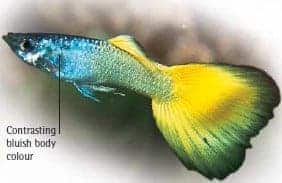types of guppies
Moscows
Moscows originate from Russia, arriving in East Germany and then
spreading around the world from there.
The first Moscows to find their way to Germany looked like what we now call “Metal Heads.”
Today the name Moscow is usually applied to solid blue Moscows
Mr. Kaden identifies two different strains of Moscow. There is the
version that has a blue front of the body and a filigree (snakeskin)
peduncle, and the version that is solid dark blue.
The filigree Moscow
arrived in Germany in 1980, with the solid version occurring ten
years later.
Mr. Kaden notes that the filigree snakeskin pattern was an
intense red and yellow covering the peduncle and tail fins, just like
the picture above.
Mr. Kaden tells us the German breeder H. Schillat attended a Moscow
guppy show in 1980, bringing back the filigree guppy. However,
he only brought back males.
All the filigree Moscow variants that followed were achieved by
crossing to females with dominant colors on the X-chromosome.
Mr.
Kaden singles out D. Sammet as the creator of a beautiful red filigree
Moscow version through crossing with a female with a red color
gene.
The filigree Moscow guppy was a big hit among East European
breeders. It spread throughout East Germany, Poland and CSSR
(Czechoslovak Socialist Republic).
Mr. Kaden tells us that the first all-blue variant was first shown
in 1990 at a Berlin DGF (German Guppy Federation) show. The
exhibitor was Hungarian.
The blue was so intense that they showed
it in the blue class. Mr. Kaden tells us the intense blue was the result
of mating with females with blue color genes.
These females actually
show blue color in the fins and the body, especially in the front of the
body. So that is another helpful guide for the Blue Moscow designer:
choose females that show a lot of blue.
Mr. Kaden says the monochrome blue variant often has a golden
(European gold, U.S. bronze, Asia tiger) version as part of the strain’s
genotype.
Nomenclature. The Moscow with a half-snake body goes by several names:
Metal Head Snakes, Moscow Snakeskins, Russian Metal Head Cobra and so on.
Moscow Color and Genetics
Although the stock from which modern Moscows were developed
were half-body snakeskin, today the Moscow is popularly considered
to be a solid-colored guppy, including a colored head.
The Blue Moscow
is the most common form, although the Green Moscow is also
plentiful. Blue and Green Moscows are essentially the same.
Green Moscows just have a lot of yellow color cells in the top layer of the
dermis.
Purple Moscows have plentiful red color cells. Some breeders
have even developed the Red Moscow.
The other common characteristic of Moscows is a black component
to the color.
This causes variation in Moscow apparent coloring from
light blue (or other pigment color) to a dark version of that color.
The black component can become so dark as to produce a Black Moscow.
However, true Black Moscows have been developed using half-black
and three-quarter black guppies.
A difference between Moscows and such Black Moscows as Onyx and Midnight blacks is that Moscow females are normal colored and not black.
What sets apart “normal” Moscow black is its highly motile pigment,
meaning the black pigment aggregates to the center of the cell and
or disperses to the cell periphery.
This gives the Moscow its famous chameleon quality, where it can vary from a light grey to a much darker black. Midnight Black Moscows do not tend to have this motile black color.
They never lose the deep blackness of their color.
What this suggests is that the black of Blue Moscows is a different
mutation affecting black color cells then that found in Midnight
Black Moscows.
In fact, in my book “Guppy Color Manual” I identify the highly
Y-linked Moscow gene as the key gene that sets Moscows apart.
It allows the front of the body to come under the influence of black
(and other) modifying genes.
This is why you can so easily develop Moscow color variations, from solid blacks, to greens, purples, reds and a variety of metal colors.
The Moscow is famous for its colored head, although other strains
can have colored heads. (Full Platinums, for example, can have white
heads.)
Add to this the fact that you can have a Moscow without a colored head! The only sure way of classifying a fish as a Moscow is to know its descent from a Moscow forefather.
In the many crosses I have done, I have found the common Moscow
phenotype, solid blue, can be easily modified, as you will see in the
varieties listed for this category.
This makes me wonder how many Moscow strains are out there under other names! In crosses between Blue Moscows and other strains you often see
the blue metallic color in F1 males in the area of the head, the upper
half of the front of the body and some blue spotting in the caudal fin.
(See the spots on the caudal fin of the Blond Blue Moscow below.)
As I just noted, this is due to completely or strictly Y-linked genes
that form a supergene.
It appears to be close to the SDR (sex determination
region) because there has not been a confirmed case of a
female who passes on the trait to her sons or daughters.
Midnight
Black females, which have a black head, and are often offered as Xlinked
Moscows are due to the Midnight gene and not the Moscow
Y-linked gene.
The rest of the body can be influenced by X-linked
genes, which is normal for guppies and not in fact a Moscow trait.
It is incorrect to say that a “Blue Moscow” is due to a single gene. A
number of genes are required to create the solid blue color.
Even the metal head and front of the body can come under different color gene control, producing silver headed Moscows, for example.
It is also incorrect to say there is “an additional black gene” in Moscows.
Claus and Ramona Oche in Germany have postulated a
MBEG (Moscow Black Extra Gene) gene for this color.
It may be autosomal recessive. In fact the Y-linked Moscow gene allows the
front of the body to be colored, which means that the same gene that
gives a half-black guppy its black peduncle can color the front of a
Moscow black as well. It is the Y-linked Moscow gene that creates
Guppy Color Strains | 201
an all-black guppy, not an “extra gene.” Recently Jim Alderson, the
American guppy breeder, declared that there is an autosomal Moscow
gene. But again, this is not a Moscow-specific gene, this is a gene
that is common to all guppies.
It just happens to express itself differently
on the Moscow because of the Y-linked gene. See my “Guppy
Color Manual for a full discussion of the Moscow gene.
Breeding the Moscow
The genotype for the basic Moscow is: XYMw. You can only produce
Moscows from Moscow males, not Moscow females.
The reason?
Guppy males have X and Y sex chromosomes, while females have
two X chromosomes.
So only males have the Y chromosome. Since the Moscow gene is tightly linked to the Y-chromosome (it cannot cross over to the X chromosome), it is always passed to sons by fathers and never to daughters.
This is the most basic observation you can make about guppy genetics, and was in fact the first, made by Johannes Schmidt in a scientific paper around 1920!
Since the Moscow Y-linked gene applies only to the front of the
body, the rest of the body is under normal genetic influence.
There is in fact nothing special about the second half of the Moscow body in
terms of color genetics, despite what breeders like Osche or Kaden might say.
However, because there is no genetic Moscow females (females do
not have the Y-linked Moscow gene), and only Moscow males can
produce Moscow sons, to “color” a Moscow, you have to use another
Moscow strain or an outcross strain that has color on the X chromosome
of the female to change your strain’s color.
For example, you can
use an American solid blue to alter the blue color of your Moscow
strain.
The solid color Moscows are particularly good to use in crosses. In
crossing to Magentas, Stoerzbach Metals, American Half-Black
greens with the Onyx allele and Pink guppies, I have been able to
create an incredible variety of strains while keeping them crosscompatible.
Difficult to see in solid color Moscows is red spots on the peduncle.
When solid Moscows have the golden mutation (called Bronze in
the U.S., tiger in Asia and Gold in Europe) the presence of red spots
is revealed.
Blue Moscow
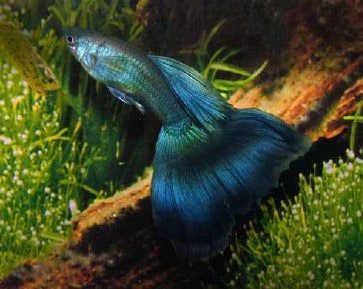
Genetics
The guppy pictured here has genetics typical of Blue Moscows, that
is a Y-linked Moscow gene and X-linked blue genes. To modify the
blue color, outcross to an American solid blue delta, or another strain
with a lot of blue color.
The Blue Moscow has a black layer of color cells underneath a
blue-light reflecting iridophore layer. See the Color Manual for how
the Tyndal Blue effect works.
What this means is that black modifier
genes and iridophore modifying genes will affect the depth and
intensity of blue.
Good outcross females to modify the blue include American blues
and Japanese blue strains.
Albino Blue Moscow
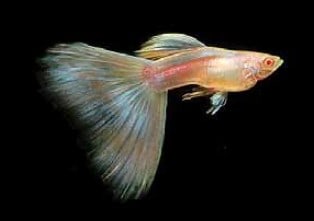
Albino Blue Moscow. Photo and guppy by ATFG.
This is a Blue Moscow with the albino gene. Notice how pale the
blue is when you remove the black layer genetically. A good plan to
enhance the blue color in grey Blues would be to breed albino Blue
Moscows for blue color and then cross to a grey Blue strain.
Blond Blue Moscow
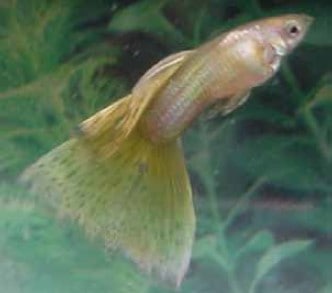
The blond Moscow shown here is a version of the Blue Moscow with
the blond gene. It has a light yellow body. Notice the spots in the
caudal fin. These are actually iridophores (metal color cells) not black
color cells.
Genetics
The blond Moscow shown above is erroneously called a “Gold
Moscow” in the U.S. and Asia. That’s because the mutation name is
“blond” not “gold.”
This particular Blond Moscow was from Tomoko Young’s fish room.
She originally acquired the strain from Jim Heller.
She crossed it into
Micariffs to enhance the yellow. Notice the red spot in the peduncle
area.
This is a very common feature of the Moscow.
The genotype for this guppy is:
XYMw bb
Where Mw = Moscow, b = blond
Asian Blau Blue Moscow
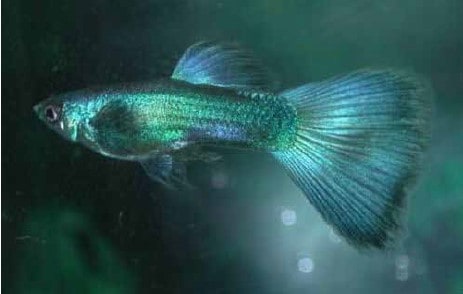
This Blue Moscow variant has no red color cells and has an overall
greenish blue color.
Genetics
The red color cells in the body are converted to iridescent blue, giving
the strain its bluish green color. A Blue Moscow was used to create
this strain.
You can see an intense blue area at the bottom of the
peduncle.
This is where a red spot on the parental strain is located.
The genotype is: XYMw AbAb
Where Mw = Moscow, Ab = Asian Blau
Golden Blue Moscow
This is the golden version (called Bronze in the U.S., Tiger Moscow
in Asia, gold in Europe) of the Blue Moscow. Typical are the red
spots on the peduncle and the spotted fins.
The females have a pronounced
reticulation pattern.
Genetics
The Golden Moscow is a Moscow homozygous for the golden (gg)
gene. The golden gene is often found in strains to make the strain
darker.
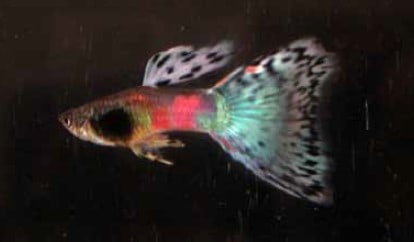
The gene appears to have been present in the Blue Moscow that
originated out of Germany. (Based on an account provided in Yoshiki
Tsutsui’s Guppy Base Book Vol. 1).
The dotted pattern in the fins is an interesting effect of the golden
gene, which results in the aggregation into spots of melanophores in
the fins. It is similar in phenotype to the spotted patterns on snakeskin
strains.
See the Guppy Color Manual for an in-depth discussion of the effect
of the golden gene on black in guppies and particularly in Moscows.
Green Moscow
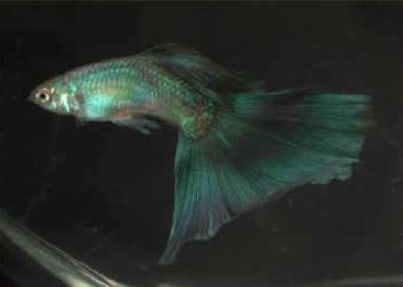
This green version of the solid Moscow is simply a Blue Moscow
with an increased number of yellow color cells.
This color is found in all Blue Moscow drops, at least to some degree. Crossing with American solid greens (or other green strains) will bias the color to
green.
Purple Moscow
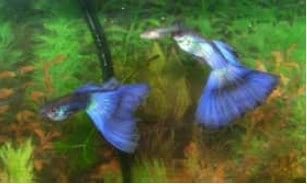
Create a purple Moscow by outcrossing to an American purple delta.
Full Red Moscow
Red Moscow. Picture courtesy of ATFG. This male has the high dorsal gene as well.
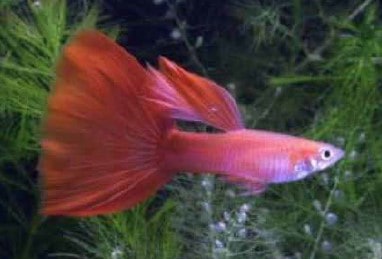
cross between a Blue Moscow male and American Full Red female.
A Full Red Moscow is sometimes difficult to distinguish from a Full
Red guppy. You have to be in possession of the guppy’s ancestry to
make the judgement, although in some strains bluish metallic color
indicates Moscow heritage.
A Full Red Moscow is Y-linked for the Moscow gene and X-linked
for Full Red.
It is created by crossing these two strains. Presumably
the red color gene can cross over to the Y chromosome to create a
Full Red Moscow with the key genes on the Y chromosome.
A strategy for creating Red Moscows from other Moscows is to
maintain two strains, the Moscow strain and Full Red strain Xlinked
for the Full Red gene. (X-linked females will display red color
in their fins and at the top of their peduncles.) Maintain the Full Red
females pure while constantly outcrossing the Moscow strain until it
has become pure Full Red.
Half-Black Red Moscow
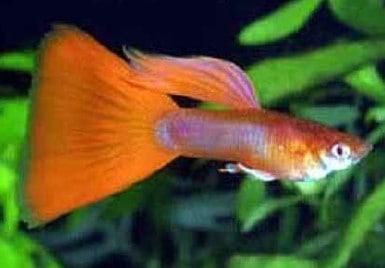
Moscow HB Red. Guppy by Takahiro Mizuguchi.
Takahiro Mizuguchi, who has been working with Moscows since the
mid-nineties, says the original Blue Moscow strain he acquired came
out of Eastern Europe. He says there was a lot of red color pigment
in the original import stock. Crossing red guppies into the Blue
Moscow enhanced the red pigment. Crossing with American delta
blues fades out the red.
I do not particularly like this version of the Full Red.
Albino Full Red Moscow
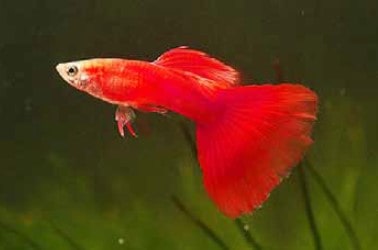
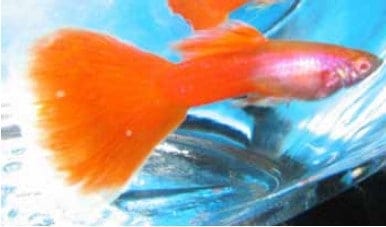
Albino full red moscow
solid red caudal and dorsal fin. Another photo of the Albino Red Moscow Oscar Inostroza, a breeder of red guppies in Canada, was experimenting with crosses want to buy Albino full red guppy
Albino Red Moscow. Guppy and photo: Oscar Inostroza
This version of the Red Moscow has an intense red coloration with a
solid red caudal and dorsal fin.
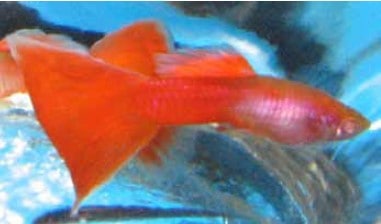
Another photo of the Albino Red Moscow
Oscar Inostroza, a breeder of red guppies in Canada, was experimenting
with crosses with his red albinos, intent on discovering their
genetics.
One of the crosses he attempted was to a Moscow imported
from Taiwan, billed as a Purple Moscow.
In fact the strain was probably a Midnight Black Moscow, one with the Midnight allele.
You can see some bluish highlights, an indication this is a recent
cross.
While most guppies have dark eyes, some actually have red eyes, There are two types of red-eyed guppies. Real Red Eye (RRE) – These are normal-colored guppies that have red eyes.
Real Red Eye Albinos (RREA) – These guppies have slightly paler red eyes, and they lack melanin, which makes them true albinos.
This trait shows red eyes and the absence of black melanin. This type of guppy can appear in many colors.
There is a Red Albino Delta and Tank class and any other colored Albino delta would be entered in the AOC(Any Other Color) class. Albinos with veils are entered in the Body/eye color class.
Type of guppies – I’m sure you were very familiar with this ornamental fish.
Widely distribute worldwide, Guppies can be easily found in any ornamental fish store
Names can vary depending on the region they are found in, but generic labels include Fan, Delta, and Veil tails, flared, triangular- shaped, swordtails (including double sword and top or bottom sword),
Lyretail, which is a combination between the double sword and Delta tails, Pin/Needletail, Spear tail, recognized by
What are fancy guppies?
Guppy Fish, Fancy Guppy. … A great tropical fish for freshwater aquarium fish beginners, the Guppy is a very hardy tropical fish that is also a very prolific breeder.
The male guppy is easy to distinguish from the female guppy because the male is usually more colorful with extremely colorful and large caudal fins (tails)
What kind of fish are guppies?
The guppy (Poecilia reticulata), also known as millionfish and rainbow fish, is one of the world’s most widely distributed tropical fish, and one of the most popular freshwater aquarium fish species. It is a member of the family Poeciliidae and, like almost all American members of the family is live-bearing.
How big do cobra guppies get?
Female guppies grow to 2 inches and the males are a bit smaller at around 1.5 inches.
Their full size will vary depending on the genes, food, nutrition and more.
They are known to be small fish and get pushed around in community tanks for that reason. Be careful of larger fish trying to eat guppies.
Can you cross breed guppies?
The only time I’ve heard about different species like guppies and mollies cross breeding is then they didn’t have their own kind in the tank.
It’s rare and has to be perfect timing for it to happen. The only ones that would very readily cross breed are Endlers and Guppies because they are so closely related.
How big do fancy guppies get?
But to answer the initial question of how big or how large in size Guppy fish grow to is 1 to 2 inches.
The males are a little bit smaller than the females and they only get to about 1 1/2 inches long while the females are A bit larger and grow to around 2 inches.
How many guppies can you have in a 10-gallon tank?
If this is the case, and a 10 gallon tank can comfortably accommodate species measuring 10” long altogether, then you can fit two male guppies and four female guppies in it.
Do guppies eat their babies?
Guppies are known for being the easiest aquarium fish to spawn. Females give live birth frequently, to well-developed offspring.
The only hitch in guppy breeding is that guppies, like most fish, have no reservations about eating their young.
guppy fish
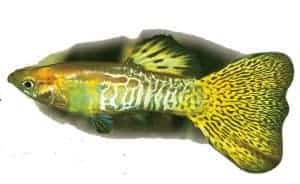
ORIGINS South America, occurring in the Caribbean and in South America north of the Amazon. SIZE 2 in (5 cm). DIET Prepared foods and small livefoods. WATER Temperature 70–77°F (21–25°C); hard (100–150 mg/l) and alkaline (pH 7.5). TEMPERAMENT Placid and social. Golden Snakeskin Delta Guppy This is one of a number of guppy varieties that have become very popular in Russia. It is thought that the famous Moscow Blue strain may have evolved from the Snakeskin line.
The snakeskin patterning can be combined with other colors, but it is usually associated with varieties displaying a broad caudal fin One of the best known of all tropical fish, the Guppy is named after Rev.Thomas Guppy, who identified it on the Caribbean island of Trinidad.
The several thousand varieties available to aquarists today are far removed from their wild ancestors, and can be found in a wide range of colors and with many different body patterns and fin types.
The different color variations are displayed most impressively in male fish, which are naturally more colorful as well as smaller than females. (All the fish illustrated here are male.)
Guppies show well as a group in a single-species tank, but they can also be kept with other nonaggressive fish as part of a community aquarium.
The female Guppy gives birth to live offspring, but unfortunately, these are likely to be cannibalized soon after birth, even in a breeding tank setup, unless the young can escape out of reach.
Various breeding traps are available for this purpose .When buying these fish, it is worth remembering that the largest females give birth to correspondingly bigger broods.
One of the most significant factors to consider when breeding guppies is that a female only needs to mate once in order to continue producing young throughout her life—potentially giving birth to seven or more broods using spermstored in her body.
This is why even if you choose a well-marked male and female from the same tank in a pet store, the likelihood will be that at least some of the young will not be the offspring of that particular male (although the majority of offspring are likely to be the result of the most recent mating).
This also explains how females kept on their own can give birth to young. The only way to be sure of the parentage of guppies is to separate the sexes as early as possible.
As soon as the young males can be recognized by their gonopodium—usually when they are about three weeks old—they should be transferred to a separate tank.
The females will be noticeably larger than the males from three months onward, by which time some of the males will already be sexually mature.
A female guppy will have her first brood approximately a month after mating. The number of offspring produced is likely to be small at first, sometimes no more than 10, but it increases to between 50 and 100 per brood as the female grows bigger.
Some strains are more prolific breeders than others. guppy breeding Selective breeding of guppies began during the 1950s, but unfortunately, a number of strains—even some that are carefully maintained—are not stable.
This means that many of the resulting offspring may not display the most desirable characteristics of their parents.
Cobra patterning is one of the most stable characteristics in terms of markings. This is a dominant genetic characteristic, so well- marked individuals are always likely to pass their cobra patterning on to the next generation.

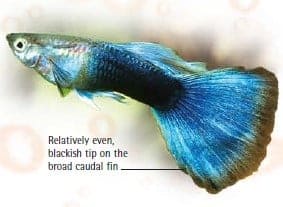
However, recessive characteristics, such as tuxedo patterning, may disappear for several generations of a particular bloodline, and then reemerge unexpectedly at a later stage. The tuxedo Tuxedo Multicolored Delta characteristic (the black area toward the rear of the body) can be combined with different colors to striking effect. This variety also has the broad delta-tail. Blue Tuxedo Guppy This particular variety is also
described as the Blue Delta-Tail Half Black, based on its body coloration. The broad caudal fin is predominantly blue, with variable black markings.
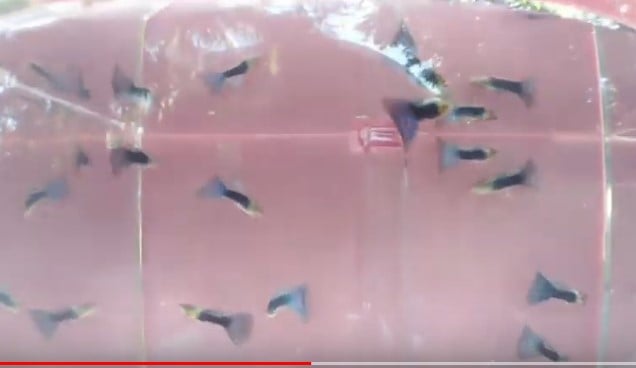
Buy this beautiful hb blue guppy here https://www.giobelkoicenter.com/product/hb-blue-guppy/
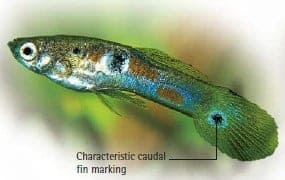

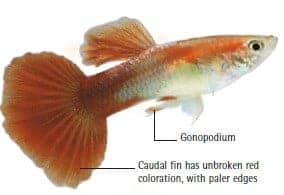
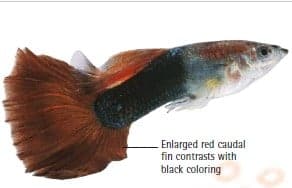
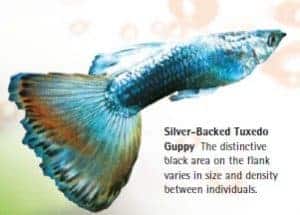



Wild Guppy These fish may be found in brackish water, and the addition of salt to their aquarium is recommended.
Wild Guppies are not readily available today, and domestic strains will prove far more adaptable.
German Yellow Guppy Named after its country of origin, this is a particularly striking variety in which the enlarged caudal fin and the dorsal fin are both yellow.
Fin shape, as well as color, is important in types of guppies fancy guppies. Blonde Guppy The red caudal fin and rear part of the body contrast with the lighter blonde coloration seen on the underparts near the head.
types of guppies The use of color food is often recommended for red strains of guppies. Red Tail Half-Black Guppy As with other strains created by selective breeding, fertility may be impaired if these fish are heavily inbred.
Not all such strains are commercial products; some are bred by enthusiasts only. Silver-Backed Tuxedo Guppy The distinctive black area on the flank varies in size and density between individuals.
Golden Snakeskin Delta Guppy types of guppies This is one of a number of guppy varieties that have become very popular in Russia.
It is thought that the famous Moscow Blue strain may have evolved from the Snakeskin line.
Red Varitail Guppy (above) Broad-tailed guppies like the Red Varitail tend to be more popular than those with narrow tails, because the wide caudal fin allows for some striking tail patterns to be developed.
Gold Cobra Delta Guppy Of American origin, Cobra Guppies are now popular internationally.
types of guppies The male (seen above) is always more colorful than the female, although she may display a patterned caudal fin in some strains.
dumbo mosaic guppy
This is the Red Mosaic Dumbo Ear strain guppy that has a beautiful red tail with the mosaic pattern on it.
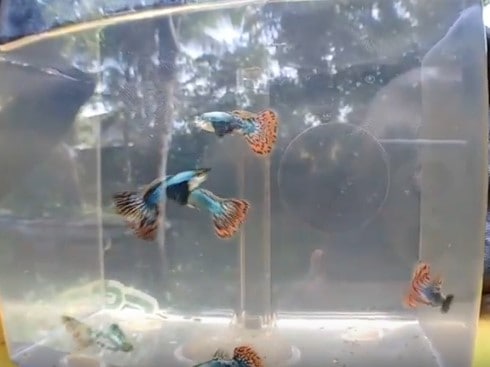
Buy this beautiful dumbo mosaic guppy here https://www.giobelkoicenter.com/product/dumbo-mosaic-guppy/
albino dumbo ear guppy
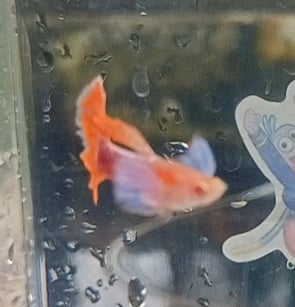
albino dumbo ear guppy this is the albino version of the big ears guppy or the dumbo ear guppies variety check out also my video below
types of guppies people ask
What are fancy guppies?
Guppy Fish, Fancy Guppy. … A great tropical fish for freshwater aquarium fish beginners, the Guppy is a very hardy tropical fish that is also a very prolific breeder.
The male guppy is easy to distinguish from the female guppy because the male is usually more colorful with extremely colorful and large caudal fins (tails)
How big do cobra guppies get?
Female guppies grow to 2 inches and the males are a bit smaller at around 1.5 inches. Their full size will vary depending on the genes, food, nutrition and more.
They are known to be small fish and get pushed around in community tanks for that reason. Be careful of larger fish trying to eat guppies.
What color are guppies?
The bodies and tales of male guppies in the wild are covered with spots and stripes of many different colors: orange, yellow, blue, violet, green, black, and white.
Do guppies eat their own babies?
Guppies are known for being the easiest aquarium fish to spawn. Females give live birth frequently, to well-developed offspring.
The only hitch in guppy breeding is that guppies, like most fish, have no reservations about eating their young.
How big do fancy guppies get?
But to answer the initial question of how big or how large in size Guppy fish grow to is 1 to 2 inches. The males are a little bit smaller than the females and they only get to about 1 1/2 inches long while the females are A bit larger and grow to around 2 inches.
Do guppies need a filter?
A filter is not compulsory as guppies don’t produce as much waste as other fish such as goldfish do.
Nevertheless, many guppy owners swear by filters, saying that they help to maintain water quality and keep the guppies healthy.
At Swell, we do recommend keeping a small filter in the tank. Resources from Encyclopedia of Aquarium and Pond Fish D. Alderton DK 2008
how many different types of guppies are there
breeding different types of guppies what will you get
how to identify types of guppies,
what types of fish can live with guppies,
which two types of guppies tended to do better no matter what habitat they were in
Although not typically found there, guppies also have tolerance to brackish water and have colonized some brackish habitats.
They tend to be more abundant in smaller streams and pools than in large, deep, or fast-flowing rivers.
What kind of environment do guppies like?
Natural Habitat
In the wild, your guppy is typically found in the clear tropical waters of Caribbean islands of Trinidad and Tobago, and on the South American continent in Venezuela, Guyana and Brazil.
He also likes brackish water that is more saline or salty than fresh water, but not as salty as sea water
what types of vegetables can i feed my guppies
Vegetables. The majority of adult guppies’ diets should consist of plant matter. Algae and spirulina are excellent staple foods for guppies.
You can also feed your guppies chopped or shredded vegetables such as mustard greens, zucchini, peas and spinach
how many different types of guppies are there

There are several features that can set each type of guppy apart, making them a versatile and colorful species. In this article, I’ve gathered 50+ guppy varieties, if you’re curious to learn more about the various types of guppies that have emerged on the market as a result of selective breeding.
breeding different types of guppies what will you get
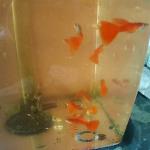
There is a popular belief that Guppies are a hardy fish which can be … Now although many fishkeepers started with Guppies, over the years the species has encountered some … As Guppies are easy breeders, with a little care you can optimise your … As a guide, if your fish do not eat all the food you put in the tank in two .
